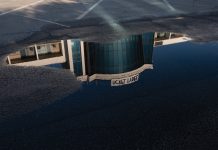
Illustration by Jun Cen
The week before Hurricane Dorian was expected to roar along Georgia’s coast, J.R. Grovner was preparing to evacuate his native home of Sapelo Island yet again.
In recent years, Grovner and the island’s other 42 residents—nearly all of whom are direct descendants of enslaved West Africans and who live in Hog Hammock, Georgia’s last surviving Gullah community—have seen more frequent hurricanes pummel the picturesque barrier island’s salt marshes, maritime forests, grasslands, and beaches.
“If sea levels rise or cover Sapelo, we lose a whole community. You’re going to lose a whole lot more than Sapelo.”
Areas that never before flooded now become waterlogged, Grovner says. As if the exodus of residents to better services and job opportunities off the island wasn’t enough of a threat to the village’s survival, the rising tide levels—even on days without storms—put its future in peril.
“If sea levels rise or cover Sapelo, we lose a whole community,” Grovner says. “You’re going to lose a whole lot more than Sapelo.”
Ocean waters have risen nearly a foot since the 1930s, and the trend shows no signs of slowing down. Climate models project an additional rise of three to six feet by the end of the century. While barrier island beaches and shorelines have seen the most noticeable effects from climate change, marshes—the wetlands that researchers say largely have avoided losses from rising sea levels—could be next. Deepak Mishra, a professor in UGA’s geography department and director of the Small Satellite Research Lab, is hoping a satellite he will help place roughly 250 miles above Earth can paint a clear picture of the coming threat.
Nature didn’t design the wetlands to be submerged, Mishra says. When they do get inundated, the areas become stressed and die off, becoming mudflats. “The general trend is very stable, but there are certain sections [along the coast] which are . . . approaching a really irreversible situation, where the marshes basically disappear and become permanently submerged.”

Photograph by Beach Cottage Photography/Getty Images
In addition to being home to herons, oysters, and numerous crab species, marshes are a natural filter that reduce sediment and chemical runoff. They also pull carbon from the atmosphere, acting as a salve to climate change. If wetlands like Georgia’s start to disappear, that carbon stays in the atmosphere, and the world continues to heat—or heat faster.
Existing satellites monitor coastal wetlands in the course of observing our planet, but it is uncommon to have a satellite focus on a specific area for an extended period of time. The satellites that do pass over Sapelo Island don’t provide very detailed imagery. The expanded vantage point of UGA’s dedicated satellite will help researchers figure out how to best manage Sapelo Island and the coast’s biodiversity-brimming marshes. That in turn could help state officials plan how to address the loss of wetlands with restoration strategies like a living shoreline project—a protected coastal edge made of natural materials such as plants—or sediment replenishment.
UGA’s satellite is a recent innovation and is much smaller than ones typically used for communication. Weighing about eight pounds and roughly the size of a tissue box, the CubeSat satellite is relatively inexpensive (about $180,000) compared to an airplane or the dozens of drones that would be necessary to obtain the same information, says Caleb Adams, cofounder of UGA’s Small Satellite Research Lab and a master’s student in computer science. It’s slated to launch in November, along with satellites used by other colleges and universities around the country. The satellite will focus on Sapelo Island, but Mishra says the goal is also to map Georgia’s 100-mile coast, from Cumberland Island to Tybee Island.
Mishra hopes that, within a month or two, the orbiter will have collected enough data to recreate a moving picture of the entire coast.
“The way sea level is rising, it’s pretty obvious that it’s going to affect a lot of these wetlands eventually,” Mishra says. “People might argue that this is a very small section of the Georgia coast that is showing some kind of warning sign. But it doesn’t take a whole lot of time for that small section to become a larger section.”
33%
Portion of remaining salt marshes along the U.S. East coast that are located in Georgia
1 foot
approximate rise in sea levels since the 1930s
138,000
number of people projected to be at risk for coastal flooding by 2050
Sources: Climate Central, 100 Miles
This article appears in our November 2019 issue.














